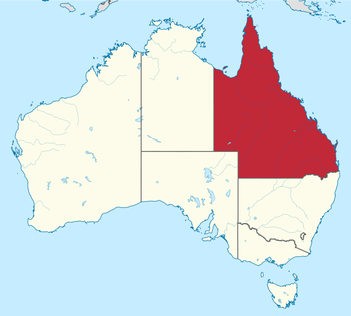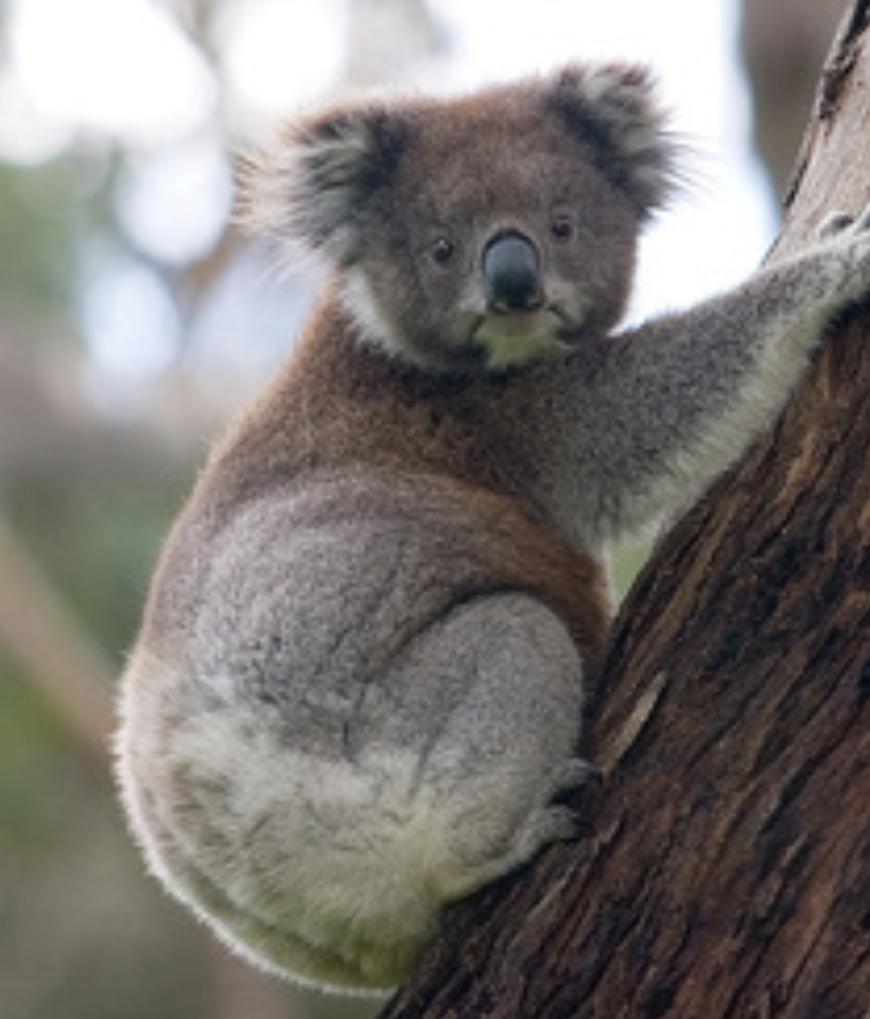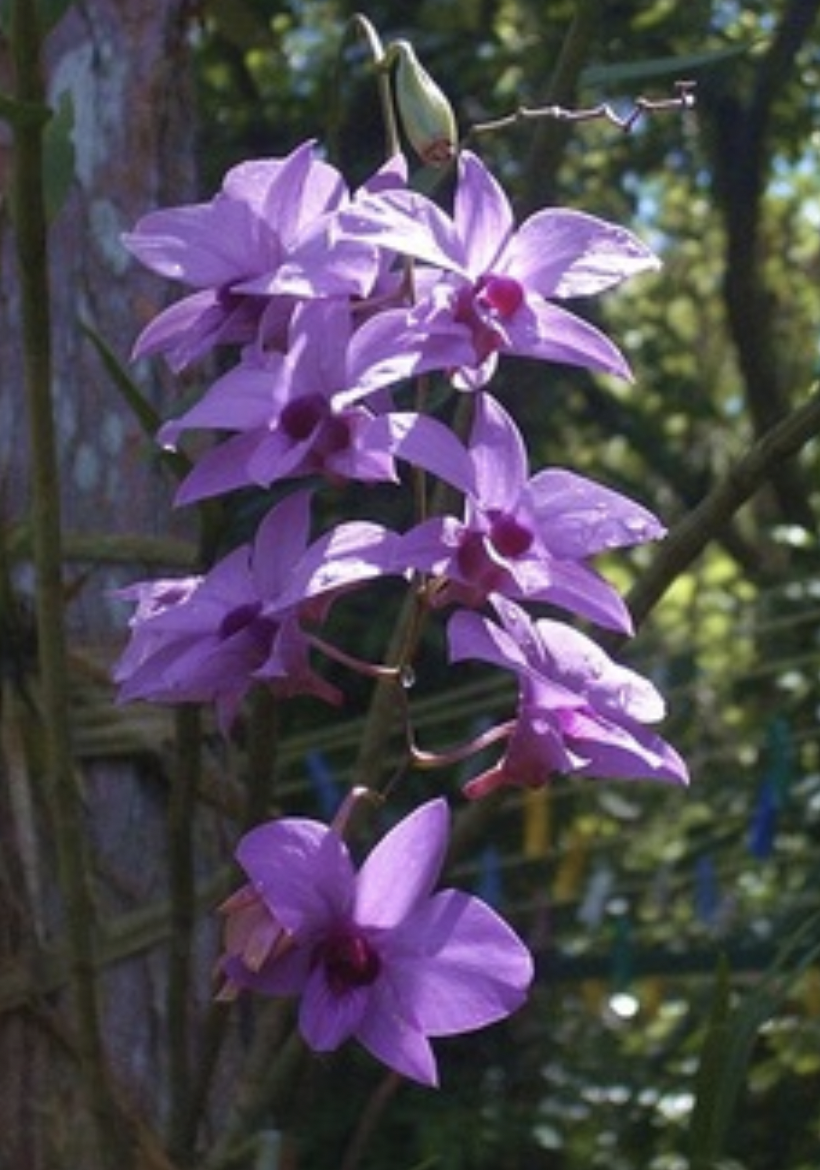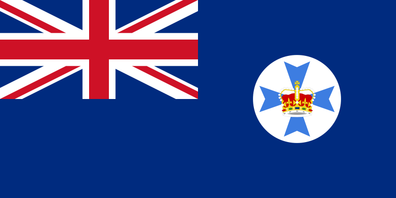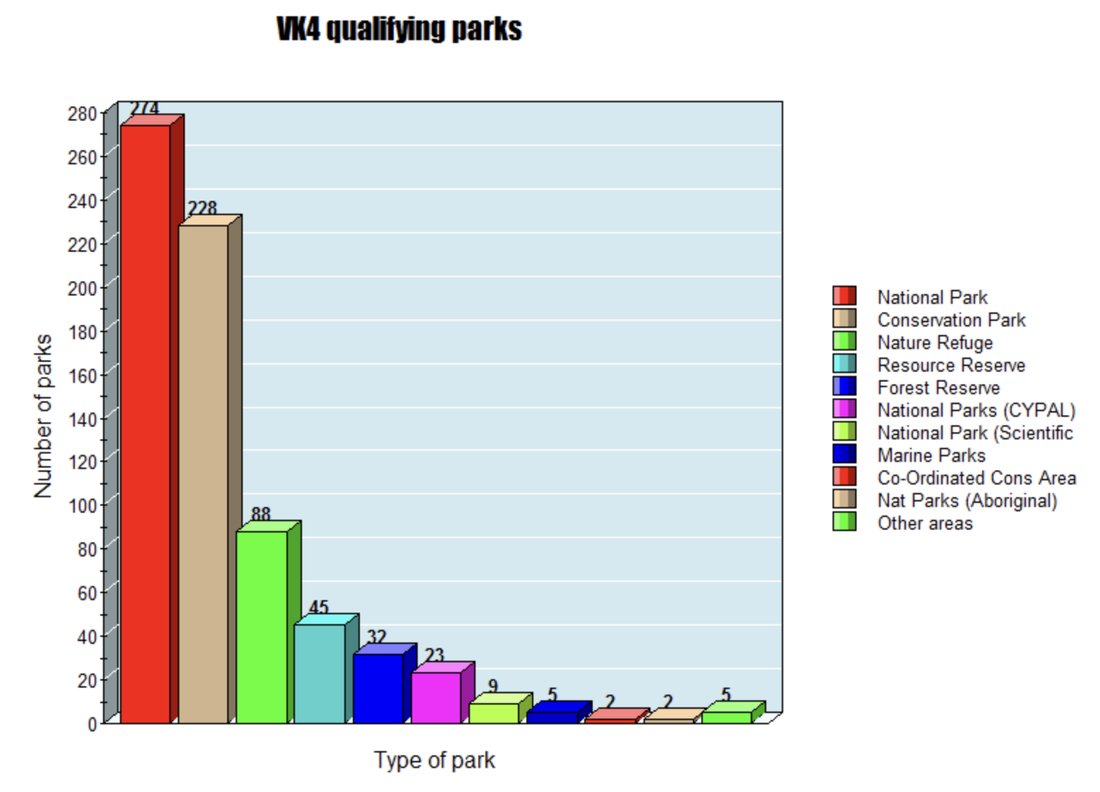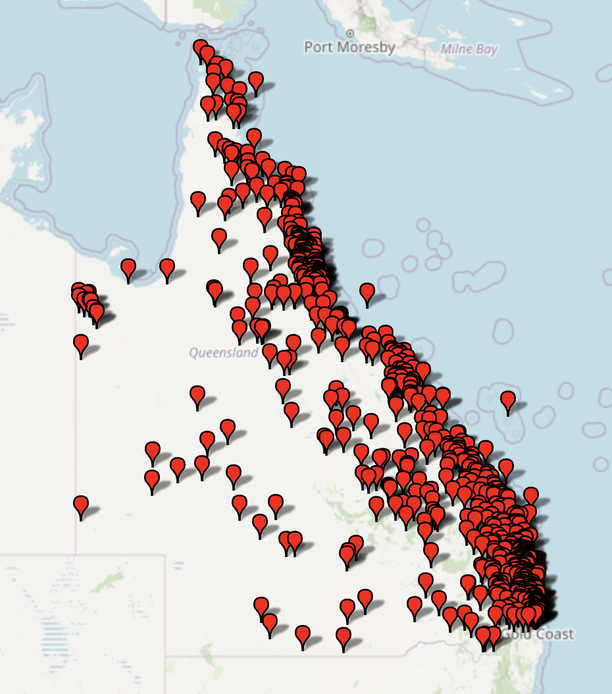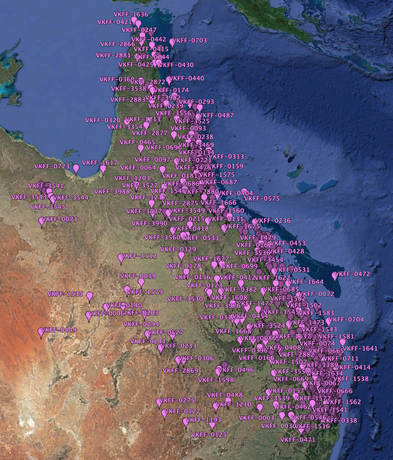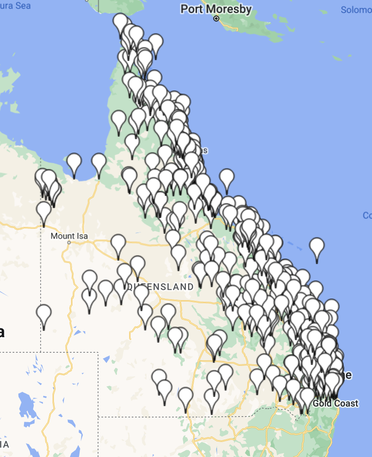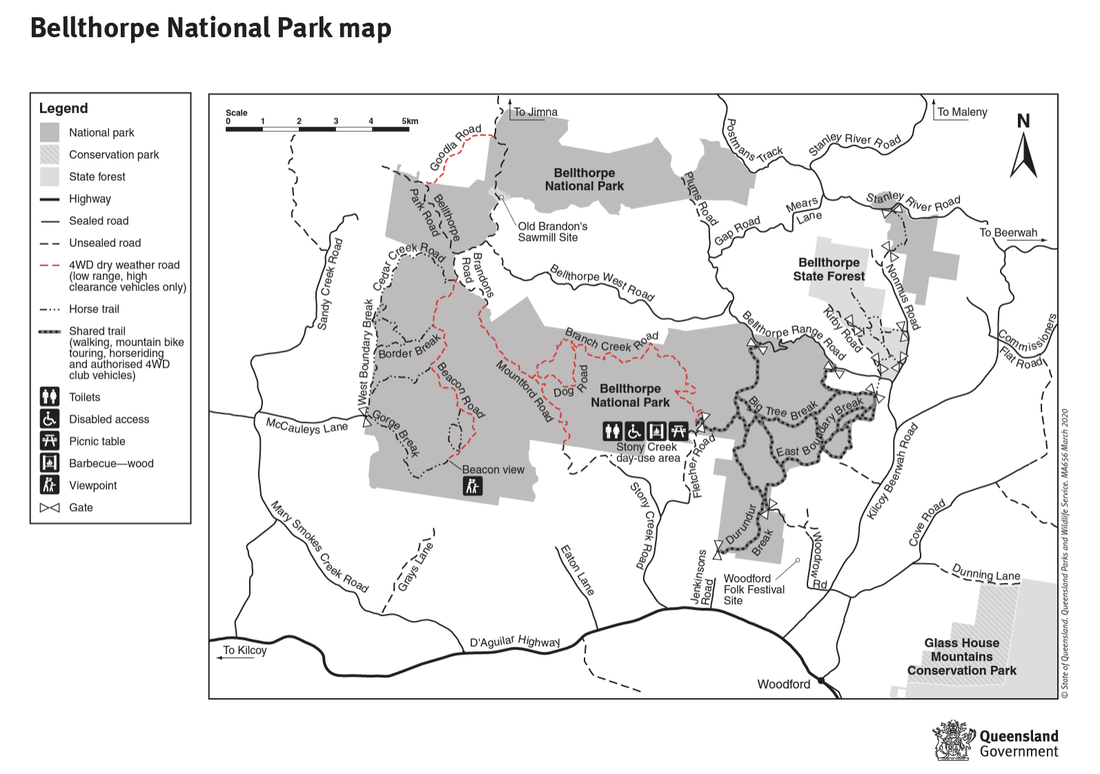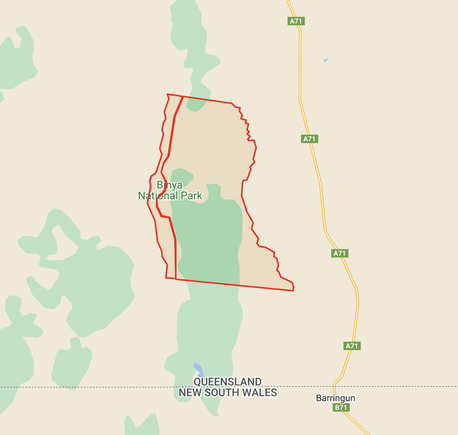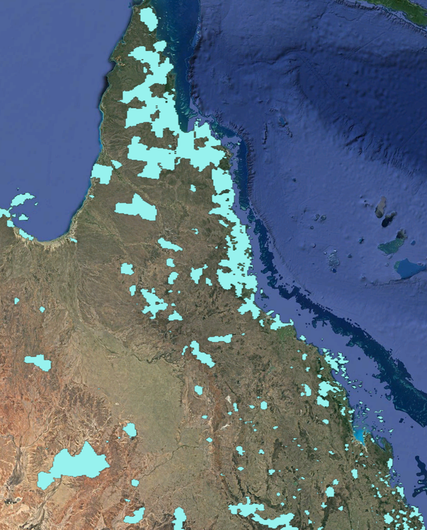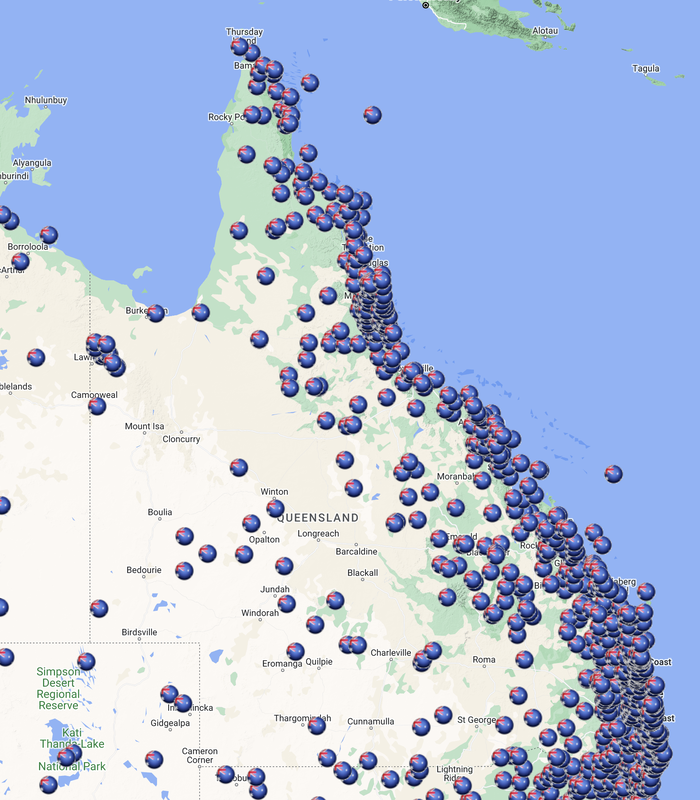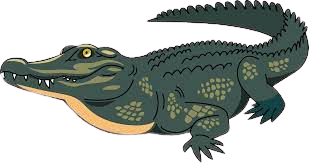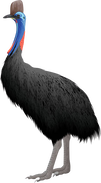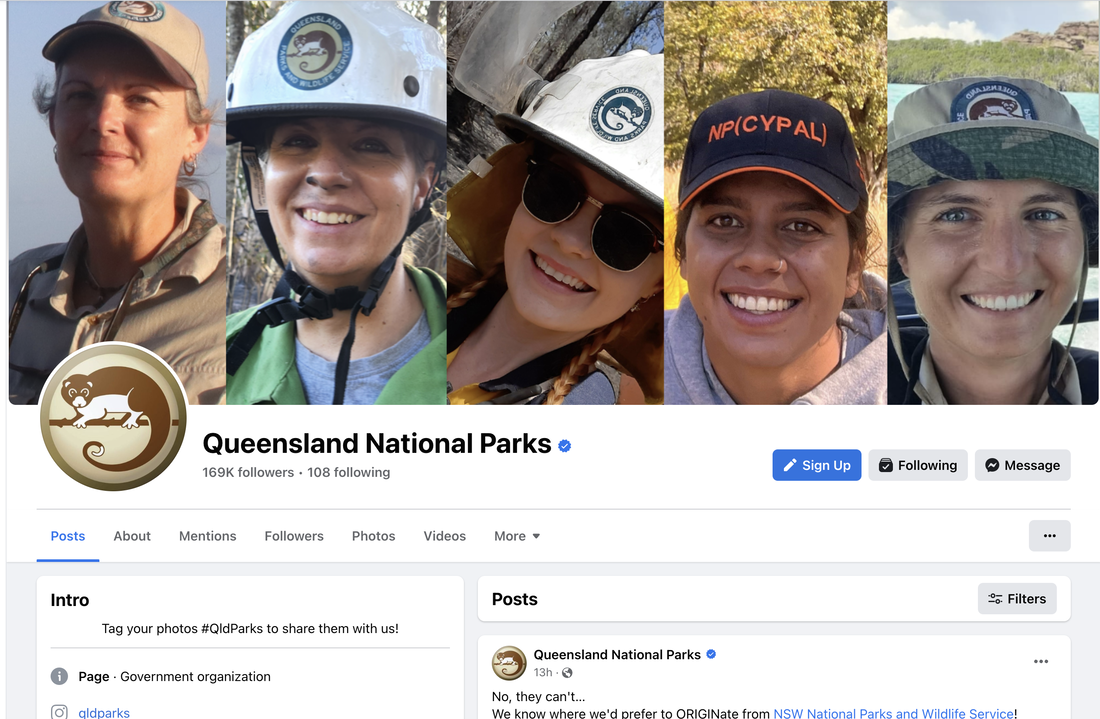QUEENSLAND (VK4)
Above:- Image c/o Wikimedia Commons.
Queensland, abbreviated as Qld, is the second largest and third most populous state in Australia.
Situated in the northeast of the country, it is bordered by the Northern Territory, South Australia and New South Wales to the west, southwest and south respectively. To the east, Queensland is bordered by the Coral Sea and Pacific Ocean.
Queensland has a population of 4,580,700, concentrated along the coast and particularly in the state's South East. The state is the world's sixth largest subnational entity, with an area of 1,852,642 km2.
The capital and largest city in the state is Brisbane, Australia's third largest city. Referred to as the 'Sunshine State', Queensland is home to 10 of Australia's 30 largest cities and is the nation's third largest economy.
Situated in the northeast of the country, it is bordered by the Northern Territory, South Australia and New South Wales to the west, southwest and south respectively. To the east, Queensland is bordered by the Coral Sea and Pacific Ocean.
Queensland has a population of 4,580,700, concentrated along the coast and particularly in the state's South East. The state is the world's sixth largest subnational entity, with an area of 1,852,642 km2.
The capital and largest city in the state is Brisbane, Australia's third largest city. Referred to as the 'Sunshine State', Queensland is home to 10 of Australia's 30 largest cities and is the nation's third largest economy.
QUEENSLAND FAUNA EMBLEM
QUEENSLAND FLORA EMBLEM
QUEENSLAND STATE FLAG.
QUEENSLAND PARKS AND WILDLIFE SERVICE.
The Queensland Parks and Wildlife Service (QPWS) is a business division of the Department of Environment and Science within the Government of Queensland. The division’s primary concern is with the management and maintenance of protected areas within Queensland, to protect and manage Queensland’s parks, forests and the Great Barrier Reef for current and future generations.
Queensland’s first national park was Witches Falls, which is located in today's Tamborine National Park, was established on the 28th day of March 1908. This was followed by the Bunya Mountains National Park in July 1908.
A dedicated national parks service was formed in 1975 from the Forestry department.
Queensland’s first national park was Witches Falls, which is located in today's Tamborine National Park, was established on the 28th day of March 1908. This was followed by the Bunya Mountains National Park in July 1908.
A dedicated national parks service was formed in 1975 from the Forestry department.
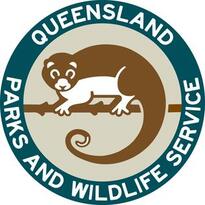
Since its formation in 1975, the QPWS has worn a badge on their uniform featuring Herbie, a Herbert River ringtail possum. It has become one of the best known symbols in Queensland.
The Herbert River ringtail possum lives in the tropical rainforests of Queensland. Their dependency on the rainforest makes them vulnerable to habitat destruction.
The Herbert River ringtail possum lives in the tropical rainforests of Queensland. Their dependency on the rainforest makes them vulnerable to habitat destruction.
Queensland is home to over 1,000 National Parks, Forest Reserves, Conservation Parks, and other protected areas, including five World Heritage Areas - more than any other State. The QPWS manages over 15.2 million hectares of land which is an area larger than 50% of the world's countries.
Parks and forests managed by the QPWS include:-
Parks and forests managed by the QPWS include:-
- National Parks and Regional Parks declared under the Nature Conservation Act 1992
- Marine Parks declared under the Marine Parks Act 2004
- Fish habitat areas declared under the Fisheries Act 1994
- State Forests and Timber Reserves declared under the Forestry Act 1959
- the Great Barrier Reef Marine Park (in partnership with the Commonwealth).
TYPES OF PARKS IN QUEENSLAND.
Above:- Image c/o 2022 CAPAD.
There are a total of 285 National Parks in Queensland, which includes 9 Scientific Nation Parks and 32 National Parks Aboriginal (Cape York Peninsula Aboriginal Land (CYPAL). (as of 21st June 2023).
In July 2016 Regional Parks were abolished and returned to the tenures of Conservation Park or Resources Reserve. The nine (9) National Parks (Scientific) were also reinstated at this time.
The National Park (Recovery) category was deleted on 24th March 2014 and has not been reinstated. This former category applied to those locations that had been declared protected areas but whose cultural and natural resources and values were considered not to be up to full national park standard at the current time of declaration. They were usually areas that had been subject to a previous use such as forestry or some form of agriculture. They were managed to restore to the greatest possible extent to the parks natural condition and protect and restore the conservation values so that they could be dedicated as a national park.
In July 2016 Regional Parks were abolished and returned to the tenures of Conservation Park or Resources Reserve. The nine (9) National Parks (Scientific) were also reinstated at this time.
The National Park (Recovery) category was deleted on 24th March 2014 and has not been reinstated. This former category applied to those locations that had been declared protected areas but whose cultural and natural resources and values were considered not to be up to full national park standard at the current time of declaration. They were usually areas that had been subject to a previous use such as forestry or some form of agriculture. They were managed to restore to the greatest possible extent to the parks natural condition and protect and restore the conservation values so that they could be dedicated as a national park.
The majority of parks in Queensland are accessible to the public, however some are considered scientific or heritage and are not accessible to the general public.
Please note Rule 4.2 of the VKFF Rules and Guidelines which states:-
"It is the responsibility of the activator to ensure that access to the reference area is permitted...."
Please note Rule 4.2 of the VKFF Rules and Guidelines which states:-
"It is the responsibility of the activator to ensure that access to the reference area is permitted...."
QUALIFYING PARKS IN QUEENSLAND.
There are currently 713 qualifying parks in Queensland for the WWFF program (as of 21st June 2023).
They consist of:-
For a full list of qualifying VK4 VKFF parks, please see the Qualifying VK4 parks page.
They consist of:-
- 274 National Parks
- 228 Conservation Parks
- 88 Nature Refuges
- 45 Resource Reserves
- 32 Forest Reserve
- 23 National Parks (CYPAL)
- 9 National Parks (Scientific)
- 5 Marine Parks
- 2 Co-ordinated Conservation Areas
- 2 National Parks (Aboriginal)
- 5 other areas.
For a full list of qualifying VK4 VKFF parks, please see the Qualifying VK4 parks page.
Above:- Graph showing the types of VKFF parks in Queensland.
Above:- Map showing the location of the VK4 VKFF qualifying parks.
A LIST OF QUALIFYING VK4 PARKS.
- Abbot Bay Conservation Park VKFF-3975
- Albinia Conservation Park VKFF-1460
- Albinia National Park VKFF-0661
- Albinia Resources Reserve VKFF-3524
- Alcock Forest Reserve VKFF-3451
- Alice Creek Nature Refuge VKFF-3481
- Alton National Park VKFF-0003
- Alwal National Park (CYPAL) VKFF-1186
- Alyxia Nature Refuge VKFF-3482
- Amamoor National Park VKFF-0662
- Anderson Street Conservation Park VKFF-1461
- Andromache Conservation Park VKFF-1462
- Annan River (Yuku-Baja-Muliku) National Park VKFF-0663
- Annan River (Yuku Baja-Muliku) Resources Reserve VKFF-3525
- Archer Point Conservation Park VKFF-1463
- Arthur Harrold Nature Refuge VKFF-3483
- Astrebla Downs National Park VKFF-0006
- Auburn River National Park VKFF-0007
- Baddow Island Conservation Park VKFF-1464
- Baffle Creek Conservation Park VKFF-1465
- Baga National Park VKFF-0352
- Bakers Creek Conservation Park VKFF-1466
- Baldy Mountain Forest Reserve VKFF-3452
- Bally Mountain Conservation Area Nature Refuge VKFF-3484
- Ban Ban National Park VKFF-0664
- Bania National Park VKFF-0665
- Bare Hill Conservation Park VKFF-1467
- Barnard Island Group National Park VKFF-0014
- Barron Gorge Forest Reserve VKFF-3983
- Barron Gorge National Park VKFF-0018
- Barubbra Island Conservation Park VKFF-1468
- Basilisk Range National Park VKFF-1187
- Batavia National Park (CYPAL) VKFF-1188
- Bayview Conservation Park VKFF-1469
- Baywulla Creek Conservation Park VKFF-1470
- Beach Road Nature Refuge VKFF-3485
- Beachmere Conservation Park VKFF-1471
- Beelbi Creek Conservation Park VKFF-1472
- Beeron National Park VKFF-1189
- Beerwah Forest Reserve VKFF-3453
- Bell Creek Conservation Park VKFF-1473
- Bellthorpe Conservation Park VKFF-1474
- Bellthorpe National Park VKFF-1190
- Belmah Conservation Park VKFF-3976
- Benarkin National Park VKFF-0666
- Bendidee National Park VKFF-0030
- Beninbi National Park VKFF-0667
- Berrinba Wetlands Nature Refuge VKFF-3486
- Bill Huxley Nature Refuge VKFF-3487
- Bingera Conservation Park VKFF-1475
- Bingera National Park VKFF-1191
- Biniirr National Park (CYPAL) VKFF-1192
- Binya National Park VKFF-1193
- Bird Island Conservation Park VKFF-1476
- Black Mountain (Kalkajaka) National Park VKFF-0035
- Blackbraes National Park VKFF-0036
- Blackdown Tableland National Park VKFF-0037
- Blackwater Conservation Park VKFF-1477
- Blackwood National Park VKFF-0038
- Bladensburg National Park VKFF-0039
- Bloomfield River Conservation Park VKFF-1478
- Bloomsbury Conservation Park VKFF-1479
- Bluff Hill National Park VKFF-0718
- Blunder Creek Reserve Nature Refuge VKFF-3488
- Boat Mountain Conservation Park VKFF-1480
- Bobbie Sattler Nature Refuge VKFF-3489
- Bolger Bay Conservation Park VKFF-1481
- Boodjamulla (Lawn Hill) National Park VKFF-0282
- Bottle Creek Conservation Park VKFF-1482
- Bouldercombe Gorge Conservation Park VKFF-1483
- Bouldercombe Gorge Resources Reserve VKFF-3526
- Bowling Green Bay Conservation Park VKFF-1484
- Bowling Green Bay National Park VKFF-0051
- Boyne Island Conservation Park VKFF-1485
- Brampton Islands National Park VKFF-0052
- Brian Burke Reserve Nature Refuge VKFF-3490
- Bribie Island National Park & Recreation Area VKFF-0053
- Broad Sound Islands National Park VKFF-0057
- Broadwater Conservation Park VKFF-1486
- Brook Islands National Park VKFF-0060
- Buccan Conservation Park VKFF-1487
- Buckleys Hole Conservation Park VKFF-1488
- Buderim Forest Park Nature Refuge VKFF-3491
- Bukkulla Conservation Park VKFF-1489
- Bulburin National Park VKFF-0668
- Bulleringa National Park VKFF-0064
- Bullock Creek Conservation Park VKFF-1490
- Bullyard Conservation Park VKFF-1491
- Bunya Mountains Conservation Park VKFF-1492
- Bunya Mountains National Park VKFF-0067
- Bunyaville Conservation Park VKFF-1493
- Burleigh Head National Park VKFF-0068
- Burleigh Knoll Conservation Park VKFF-1494
- Burrum Coast National Park VKFF-0070
- Bustard Head Conservation Park VKFF-1495
- Byfield Conservation Park VKFF-1496
- Byfield National Park VKFF-0072
- Byron Creek Conservation Park VKFF-1497
- Cabbage Tree Point Conservation Park VKFF-1498
- Calliope Conservation Park VKFF-1499
- Caloundra Conservation Park VKFF-1500
- Cania Gorge National Park VKFF-0074
- Canunrga Conservation Park VKFF-1501
- Canyon Resources Reserve VKFF-3527
- Cape Capricorn Conservation Park VKFF-1502
- Cape Hillsborough National Park VKFF-0077
- Cape Melville National Park (CYPAL) VKFF-0079
- Cape Moreton Conservation Park VKFF-1503
- Cape Pallarenda Conservation Park VKFF-1504
- Cape Palmerston National Park VKFF-0080
- Cape Upstart National Park VKFF-0082
- Capricorn Coast National Park VKFF-0084
- Capricornia Cays National Park VKFF-0085
- Capricornia Cays (Scientific) National Park VKFF-0704 (permit required to operate from this park. See QLD Govt Parks and forests website).
- Carbrook Wetlands Conservation Park VKFF-1505
- Carello Palm Swamp Conservation Park VKFF-1506
- Carnarvon National Park VKFF-0086
- Carraba Conservation Park VKFF-1507
- Castle Tower National Park VKFF-0089
- Causeway Lake Conservation Park VKFF-1508
- Charon Point Conservation Park VKFF-1509
- Cherbourg Conservation Park VKFF-1510
- Cherbourg National Park VKFF-0669
- Chesterton Range National Park VKFF-0096
- Chillagoe-Mungana Caves National Park VKFF-0097
- Claremont Isles National Park VKFF-0099
- Clear Mountain Conservation Park VKFF-1511
- Clump Mountain National Park VKFF-0101
- Coalstoun Lakes National Park VKFF-0103
- Combo Conservation Park VKFF-1512
- Connors Forest Reserve VKFF-3454
- Conondale Conservation Park VKFF-1513
- Conondale National Park VKFF-0109
- Conondale Resources Reserve VKFF-3528
- Conway Conservation Park VKFF-1514
- Conway National Park VKFF-0110
- Conway West Conservation Park VKFF-1515
- Coolmunda Conservation Park VKFF-1516
- Coolnwynpin Nature Refuge VKFF-3492
- Coolnwynpin Creek Corridor Koala (A) VKFF-3493
- Cooloola (Noosa River) Resources Reserve VKFF-3529
- Cooloothin Conservation Park VKFF-1517
- Cooloothin Creek Nature Refuge VKFF-3494
- Coolum Creek Conservation Park VKFF-1518
- Coolum Creek Nature Refuge VKFF-3495
- Coombabah Lake Conservation Park VKFF-1519
- Cooroibah Conservation Park VKFF-3977
- Cooroibah Environmental Reserve Nature Refuge VKFF-3496
- Coral Sea Marine Park VKFF-3993
- Cordalba National Park VKFF-0729
- Cornubia Forest Nature Refuge VKFF-2865
- Crater Lakes National Park VKFF-0118
- Crediton Forest Reserve VKFF-3455
- Cressbrook Conservation Park VKFF-1520
- Crohamhurst Conservation Park VKFF-1521
- Crows Nest National Park VKFF-0121
- Cudmore (Limited Depth) National Park VKFF-0123
- Cudmore Resources Reserve VKFF-3530
- Culgoa Floodplain National Park VKFF-0125
- Currawinya National Park VKFF-0127
- Currimundi Lake (Kathleen McArthur) Conservation Park VKFF-1522
- Currumbin Hill Conservation Park VKFF-1523
- Curtain Fig National Park VKFF-0670
- Curtis Island Conservation Park VKFF-1524
- Curtis Island National Park VKFF-0128
- D'Aguilar National Park VKFF-0129
- Daarrba National Park (CYPAL) VKFF-1194
- Daintree National Park VKFF-0130
- Daisy Hill Conservation Park VKFF-1525
- Dalrymple National Park VKFF-0131
- Dan Dan National Park VKFF-0672
- Danbulla National Park VKFF-0671
- Danbulla South Forest Reserve VKFF-3456
- Danbulla South 2 Forest Reserve VKFF-3457
- Danbulla West Forest Reserve VKFF-3984 3458
- David Fleay Conservation Park VKFF-1526
- Davies Creek National Park VKFF-0134
- Dawes National Park VKFF-0673
- Dawson River Conservation Park VKFF-1527
- Dawson Road Nature Refuge VKFF-3497
- Deception Bay Conservation Park VKFF-1528
- Deepwater National Park VKFF-0135
- Deer Reserve National Park VKFF-0674
- Denham Group National Park VKFF-0136
- Denmark Hill Conservation Park VKFF-1529
- Diamantina National Park VKFF-0140
- Dinden Conservation Park VKFF-1530
- Dinden National Park VKFF-0675
- Dinden West Forest Reserve VKFF-3459
- Dipperu (Scientific) National Park VKFF-0141 (permit required to operate from this park. See QLD Govt Parks and forests website).
- Djilgarin Conservation Park VKFF-1531
- Djiru National Park VKFF-0676
- Doonan Wetlands Nature Refuge VKFF-3498
- Doonella Wetlands Nature Refuge VKFF-3499
- Double Island Point Conservation Park VKFF-1532
- Dryander Forest Reserve VKFF-3460
- Dryander National Park VKFF-0147
- Duggan Conservation Park VKFF-1533
- Dularcha National Park VKFF-0149
- Dwyers Scrub Conservation Park VKFF-1534
- Earl Hill Conservation Park VKFF-3978
- East Mount Mellum Nature Refuge VKFF-3500
- Elgin Vale Forest Reserve VKFF-3461
- Elizabeth Springs Conservation Park VKFF-1535
- Ella Bay National Park VKFF-0153
- Endeavour River National Park VKFF-0155
- Endeavour River Resources Reserve VKFF-3531
- Epping Forest (Scientific) National Park VKFF-0156 (permit required to operate from this park. See QLD Govt Parks and forests website).
- Erringibba National Park VKFF-0157
- Errk Oykangand National Park (CYPAL) VKFF-0320
- Esk National Park VKFF-0677
- Etty Bay Road Conservation Park VKFF-1536
- Eubenangee Swamp National Park VKFF-0159
- Eudlo Creek Conservation Park VKFF-1537
- Eudlo Creek National Park VKFF-0161
- Eumundi Conservation Park VKFF-1538
- Eungella National Park VKFF-0162
- Eurimbula National Park VKFF-0163
- Eurimbula Resources Reserve VKFF-3532
- Evelyn Creek Conservation Park VKFF-1539
- Ex-HMAS Brisbane Conservation Park VKFF-1540 (Entry to the park is prohibited without a permit or written approval.).
- Expedition (Limited Depth) National Park VKFF-0166
- Expedition National Park VKFF-1195
- Fairlies Knob National Park VKFF-0167
- Family Islands National Park VKFF-0168
- Fan Palm Conservation Reserve VKFF-3980
- Ferntree Creek National Park VKFF-0169
- Finucane Island National Park VKFF-0723
- Fitzroy Island National Park VKFF-0172
- Flagstone Creek Conservation Park VKFF-1541
- Flat Top Range Resources Reserve VKFF-3533
- Flinders Group National Park (CYPAL) VKFF-0174
- Flinders Peak Conservation Park VKFF-1542
- Forest Den National Park VKFF-0178
- Fort Lytton National Park VKFF-0179
- Forty Mile Scrub National Park VKFF-0181
- Frankland Group National Park VKFF-0184
- Freshwater National Park VKFF-0187
- Frizzos Nature Refuge VKFF-3501
- Futter Creek Conservation Park VKFF-1543
- Gadgarra Forest Reserve VKFF-3462
- Gadgarra National Park VKFF-1196
- Garden Island Conservation Park VKFF-1544
- Gatton National Park VKFF-0678
- Geham National Park VKFF-0679
- Gheebulum Kunnungai (Moreton Island) National Park VKFF-0332
- Ghungalu Conservation Park VKFF-1545
- Girramay National Park VKFF-0152
- Girraween National Park VKFF-0198
- Girraween Nature Refuge VKFF-3502
- Girringun Conservation Park VKFF-1546
- Girringun National Park VKFF-0199
- Girringun Resources Reserve VKFF-3534
- Glass House Mountains Conservation Park VKFF-1547
- Glass House Mountains National Park VKFF-0200
- Glastonbury National Park VKFF-1197
- Glenbar National Park VKFF-0680
- Gloucester Island National Park VKFF-0202
- Goat Island (Noosa River) Conservation Park VKFF-1548
- Goat Island Conservation Park VKFF-1549
- Goneaway National Park VKFF-0203
- Good Night Scrub National Park VKFF-0206
- Goodedulla National Park VKFF-0205
- Goold Island National Park VKFF-0207
- Goomboorian National Park VKFF-0722
- Granville Conservation Park VKFF-1550
- Great Barrier Reef Marine Park VKFF-0575
- Great Barrier Reef Coast Marine Park VKFF-3991
- Great Basalt Wall National Park VKFF-0215
- Great Sandy Conservation Park VKFF-1551
- Great Sandy Marine Park VKFF-0186
- Great Sandy Resources Reserve VKFF-3535
- Green Island National Park VKFF-0217
- Grey Peaks National Park VKFF-0220
- Grongah National Park VKFF-0681
- Gulngay National Park VKFF-3986
- Gurgeena Conservation Park VKFF-1552
- Gympie National Park VKFF-0682
- Halifax Bay Wetlands National Park VKFF-0225
- Hallorans Hill Conservation Park VKFF-1553
- Hampton National Park VKFF-0683
- Hann Tableland National Park VKFF-0226
- Harry Spring Conservation Park VKFF-1554
- Hasties Swamp National Park VKFF-0229
- Hawkesbury Road Nature Refuge VKFF-3503
- Hays Inlet Conservation Park VKFF-1555
- Heathlands Resources Reserve VKFF-2866
- Hell Hole Gorge National Park VKFF-0233
- Henderson Reserve Nature Refuge VKFF-3504
- Herberton Range Conservation Park VKFF-1556
- Herberton Range National Park VKFF-0721
- Highworth Bend Conservation Park VKFF-1557
- Hinchinbrook Island National Park VKFF-0235
- Holbourne Island National Park VKFF-0236
- Homevale Conservation Park VKFF-1558
- Homevale National Park VKFF-0237
- Homevale Resources Reserve VKFF-3536
- Hope Islands National Park VKFF-0238
- Horseshoe Bay Lagoon Conservation Park VKFF-1559
- Horeshoe Lagoon Conservation Park VKFF-1560
- Howick Group National Park (CYPAL) VKFF-0239
- Hull River National Park VKFF-0240
- Humboldt National Park VKFF-1198
- Idalia National Park VKFF-0241
- Indooroopilly Island Conservation Park VKFF-1561
- Ipswich Pteropus Conservation Park VKFF-1562
- Irongate Conservation Park VKFF-1563
- Isla Gorge National Park VKFF-0245
- Jack Smith Scrub Conservation Park VKFF-1564
- Jalum Conservation Park VKFF-1565
- Japoon Forest Reserve VKFF-3463
- Japoon National Park VKFF-0246
- Jardine River National Park VKFF-0247
- Jardine River Resources Reserve VKFF-2867
- Jill Chamberlain Nature Refuge VKFF-3505
- Johns Landing Nature Refuge VKFF-3506
- Joseph Banks (Round Hill Head) Conservation Park VKFF-1566
- Jumrum Creek Conservation Park VKFF-1567
- Junee National Park VKFF-0685
- Juunju Daarrba Nhirrpan National Park (CYPAL) VKFF-1199
- K'Gari (Fraser Island) Great Sandy National Park VKFF-0216
- Kamerunga Conservation Park VKFF-1568
- Keatings Lagoon Conservation Park VKFF-1569
- Kelvin National Park VKFF-1200
- Kelvin Forest Reserve VKFF-3464
- Kenilworth Bluff Nature Refuge VKFF-3507
- Kennedy Road Gravel Resources Reserve VKFF-3537
- Keppel Bay Islands National Park VKFF-0261
- Keppel Bay Islands (Scientific) National Park VKFF-0262 (permit required to operate from this park. See QLD Govt Parks and forests website).
- Keppel Sands Conservation Park VKFF-1570
- Keyser Island Conservation Park VKFF-1571
- King Conservation Park VKFF-1572
- King Island Conservation Park VKFF-1573
- Kingsgate Drive Nature Refuge VKFF-3508
- Kinrara National Park VKFF-0686
- Kirrama National Park VKFF-0687
- Knapp Creek Conservation Park VKFF-1574
- Koala Bushland Coordinated Conservation Area VKFF-3981
- Koala Crossing Nature Reserve VKFF-3987
- Kondalilla National Park VKFF-0266
- Koombooloomba Conservation Park VKFF-1575
- Koombooloomba National Park VKFF-1201
- Koombooloomba South Forest Reserve VKFF-3465
- Kroombit Tops National Park VKFF-0270
- Kulla (McIlwraith Range) National Park (CYPAL) VKFF-0724
- Kulla (McIlwraith Range) Resources Reserve VKFF-3538
- Kuraby Nature Refuge VKFF-3509
- Kuranda Forest Reserve VKFF-3466
- Kuranda National Park VKFF-0688
- Kuranda West Forest Reserve VKFF-3467
- Kurrimine Beach Conservation Park VKFF-1576
- Kurrimine Beach National Park VKFF-0273
- Kurwongbah Park Nature Refuge VKFF-2868
- Kutini-Payamu (Iron Range) National Park (CYPAL) VKFF-0244
- Lake Bindegolly National Park VKFF-0275
- Lake Broadwater Conservation Park VKFF-1577
- Lake Broadwater Resources Reserve VKFF-3539
- Lake Dartmouth Nature Refuge VKFF-2869
- Lake Murphy Conservation Park VKFF-1578
- Lama Lama National Park (CYPAL) VKFF-0726
- Lamington National Park VKFF-0280
- Lark Quarry Conservation Park VKFF-1579
- Lawn Hill (Arthur Creek) Resources Reserve VKFF-3540
- Lawn Hill (Creek) Resources Reserve VKFF-3541
- Lawn Hill (Gorge Mouth) Resources Reserve VKFF-3542
- Lawn Hill (Gregory) Resources Reserve VKFF-3544
- Lawn Hill (Gregory River Base) Resources Reserve VKFF-3543
- Lawn Hill (Lilydale) Resources Reserve VKFF-3545
- Lawn Hill (Littles Range) Resources Reserve VKFF-3546
- Lawn Hill (Stockyard Creek) Resources Reserve VKFF-3547
- Lawn Hill (Widdallion) Resources Reserve VKFF-3548
- Leslie Parade Nature Refuge VKFF-3510
- Limestone Creek Conservation Park VKFF-1580
- Lindeman Islands National Park VKFF-0288
- Litttabella Conservation Park VKFF-1581
- Littabella National Park VKFF-0290
- Little Mulgrave Forest Reserve VKFF-3468
- Little Mulgrave National Park VKFF-1202
- Littleton National Park VKFF-1203
- Littleton Resources Reserve VKFF-3988
- Lizard Island National Park VKFF-0293
- Lochern National Park VKFF-0294
- Lockyer National Park VKFF-0719
- Lockyer Resources Reserve VKFF-3989
- Long Grass Nature Refuge VKFF-3994
- Long Island Bend Conservation Park VKFF-1582
- Lords Table Mountain Nature Refuge VKFF-3995
- Maalan National Park VKFF-0689
- Ma'alpiku Island National Park (CYPAL) VKFF-0430
- Macalister Range Forest Reserve VKFF-3469
- Macalister Range National Park VKFF-1204
- MacKenzie Island Conservation Park VKFF-1583
- Magnetic Island Conservation Park VKFF-3979
- Magnetic Island National Park VKFF-0299
- Main Beach Conservation Park VKFF-1584
- Main Range National Park VKFF-0300
- Malanda Falls Conservation Park VKFF-1585
- Malbon Thompson Conservation Park VKFF-1586
- Malbon Thompson Forest Reserve VKFF-3470
- Maleny National Park VKFF-0690
- Manani Nature Refuge VKFF-3996
- Mapleton Conservation Park VKFF-1587
- Mapleton Forest Reserve VKFF-3471
- Mapleton National Park VKFF-1205
- Mapleton Falls National Park VKFF-0303
- Mareeba Tropical Savanna and Wetland Nature Refuge VKFF-2870
- Maria Creek National Park VKFF-0691
- Mariala National Park VKFF-0306
- Marist Brothers Nature Refuge VKFF-3511
- Maroochy 2 Forest Reserve VKFF-3472
- Maroochy River Conservation Park VKFF-1588
- Maroochy Wetlands Conservation Park VKFF-1589
- Marpa National Park (CYPAL) VKFF-1206
- Mazeppa National Park VKFF-0310
- Meingan Creek Conservation Park VKFF-1590
- Melsonby (Gaarraay) National Park (CYPAL) VKFF-0692
- Meridan Plains Conservation Park VKFF-1591
- Michaelmas and Upolu Cays National Park VKFF-0313
- Middle Percy Island Conservation Park VKFF-1592
- Millstream Conservation Park VKFF-1593
- Millstream Falls National Park VKFF-0315
- Mimosa Park Nature Refuge VKFF-2871
- Minerva Hills National Park VKFF-0318
- Mitrinchi Island National Park (CYPAL) VKFF-0425 (there is no public access to this park)
- Moggill Conservation Park VKFF-1594
- Molle Islands National Park VKFF-0323
- Mon Repos Conservation Park VKFF-1595
- Moogerah Peaks National Park VKFF-0326
- Mooloolah (Marie Higgs) Conservation Park VKFF-1596
- Mooloolah River National Park VKFF-0327
- Mooloolah River Nature Refuge VKFF-3512
- Moonstone Hill Resources Reserve VKFF-3549
- Moorrinya National Park VKFF-0329
- Moresby Range National Park VKFF-0331
- Moresby Range Resources Reserve VKFF-3550
- Moreton Bay Marine Park VKFF-3992
- Morgan Park Conservation Park VKFF-1597
- Morven Conservation Park VKFF-1598
- Mount Abbot (Scientific) National Park VKFF-1207 (permit required to operate from this park. See QLD Govt Parks and forests website).
- Mount Aberdeen National Park VKFF-0335
- Mount Archer National Park VKFF-0336
- Mount Barney National Park VKFF-0338
- Mount Bauple (Scientific) National Park VKFF-0693 (permit required to operate from this park. See QLD Govt Parks and forests website).
- Mount Beau Brummell Conservation Park VKFF-1599
- Mount Binga Forest Reserve VKFF-3473
- Mount Binga National Park VKFF-0694
- Mount Blandy Conservation Park VKFF-1600
- Mount Blarney Conservation Park VKFF-1601
- Mount Chinghee National Park VKFF-0340
- Mount Colosseum National Park VKFF-0342
- Mount Cook National Park VKFF-0343
- Mount Coolum National Park VKFF-0344
- Mount Cooroy Conservation Park VKFF-1602
- Mount Croll Nature Refuge VKFF-2872
- Mount Crosby Weir Nature Refuge VKFF-2873
- Mount Dumaresq Conservation Park VKFF-1603
- Mount Eerwah Conservation Park VKFF-1604
- Mount Etna Caves National Park VKFF-0346
- Mount Fisher Forest Reserve VKFF-3474
- Mount Hector Conservation Park VKFF-1605
- Mount Hopeful Conservation Park VKFF-1606
- Mount Hypipamee National Park VKFF-0349
- Mount Kinchant Conservation Park VKFF-1607
- Mount Leura Conservation Park VKFF-1608
- Mount Lewis National Park VKFF-1208
- Mount Mackay National Park VKFF-0695
- Mount Martin National Park VKFF-0354
- Mount Monty Rainforest Nature Refuge VKFF-3997
- Mount Ninderry Nature Refuge VKFF-3513
- Mount O'Connell National Park VKFF-0356
- Mount Ossa National Park VKFF-0357
- Mount Perry Conservation Park VKFF-1609
- Mount Perry Resources Reserve VKFF-3551
- Mount Peter Conservation Park VKFF-1610
- Mount Petrie Road Nature Refuge VKFF-3998
- Mount Pinbarren National Park VKFF-0359
- Mount Rosey Resources Reserve VKFF-3552
- Mount Scoria Conservation Park VKFF-1611
- Mount Spurgeon National Park VKFF-0720
- Mount Stanley Forest Reserve VKFF-3985
- Mount Walsh National Park VKFF-0363
- Mount Whitfield Conservation Park VKFF-1612
- Mount Windsor National Park VKFF-0696
- Mount Zero-Taravale Nature Refuge VKFF-2874
- Mountain Creek Conservation Area Nature Refuge VKFF-3514
- Mouth of Baffle Creek Conservation Park VKFF-1613
- Mouth of Kolan River Conservation Park VKFF-1614
- Mowbray Conservation Park VKFF-1615
- Mowbray National Park VKFF-0367
- Mudlo National Park VKFF-0697
- Mud Island Conservation Park VKFF-1616
- Mud Springs Nature Refuge VKFF-3999
- Munga-Thirri National Park VKFF-0449
- Murray's Environmental Nature Refuge VKFF-3515
- Mutton Hole Wetlands Conservation Park VKFF-1617
- Muundhi (Jack River) National Park (CYPAL) VKFF-0684
- Myall Park Nature Refuge VKFF-4000
- Myora Conservation Park VKFF-1618
- Nairana National Park VKFF-0699
- Nangur National Park VKFF-0700
- Naree Budjong Djara Conservation Park VKFF-1619
- Naree Budjong Djara (North Stradbroke Island) National Park VKFF-1209 (has a restricted access area)
- Narkoola National Park VKFF-1210
- Narrien Range National Park VKFF-0382
- Nerang Conservation Park VKFF-1620
- Nerang National Park VKFF-1211
- Neurum Creek Conservation Park VKFF-1621
- Newcastle Range-The Oaks Nature Refuge VKFF-2875
- Newport Conservation Park VKFF-1622
- Newry Islands National Park VKFF-0387
- Ngalba Bulal National Park VKFF-0093
- Nicoll Scrub National Park VKFF-0388
- Ningi Creek Conservation Park VKFF-1623
- Noosa Conservation Park VKFF-1624
- Noosa National Park VKFF-0391
- Noosa Resources Reserve VKFF-3553
- North Pine Dam Nature Refuge VKFF-2876
- North Pointer Conservation Park VKFF-1625
- Northumberland Islands National Park VKFF-0394
- Nour Nour National Park VKFF-0701
- Nuga Nuga National Park VKFF-0396
- Numala Community Nature Refuge VKFF-4001
- Numinbah Conservation Area Nature Refuge VKFF-3516
- Nunkeri Nature Refuge VKFF-4002
- O'Regan Creek Conservation Park VKFF-1626
- Oakview National Park VKFF-1212
- Olkola National Park (CYPAL) VKFF-1213
- Olkola (Kurrumbila) Resources Reserve 2 VKFF-3554
- Orkadilla Nature Refuge VKFF-4003
- Orpheus Island National Park VKFF-0404
- Oyala Thumotang National Park (CYPAL) VKFF-0369
- Oyala Thumotang Resources Reserve VKFF-3555
- Palmer Goldfield Resources Reserve VKFF-2877
- Palmerston Rocks National Park VKFF-0407
- Palmgrove (Scientific) National Park VKFF-0408 (permit required to operate from this park. See QLD Govt Parks and forests website).
- Palmview Conservation Park VKFF-1627
- Paluma Range National Park VKFF-0409
- Parklands Conservation Park VKFF-1628
- Pattens Nature Refuge VKFF-3517
- Peak Range National Park VKFF-0412
- Pelion Forest Reserve VKFF-3475
- Pellings Scrub Nature Refuge VKFF-4004
- Pember's Scrub Nature Refuge VKFF-4005
- Penda Scrub Nature Refuge VKFF-3518
- Percy Isles National Park VKFF-1214
- Phiara Downs Nature Refuge VKFF-4006
- Pidna National Park VKFF-0702
- Pimpana Conservation Park VKFF-1629
- Pine Ridge Conservation Park VKFF-1630
- Pinnacles National Park VKFF-1215
- Pioneer Peaks National Park VKFF-0413
- Pipeclay National Park VKFF-0414
- Piper Islands National Park (CYPAL) VKFF-0415
- Plunkett Conservation Park VKFF-1631
- Police Paddock Conservation Park VKFF-1632
- Policemans Spur Nature Refuge VKFF-3519
- Pooh Corner Nature Refuge VKFF-2878
- Poona National Park VKFF-0416
- Porcupine Gorge National Park VKFF-0418
- Possession Island National Park VKFF-0421
- Precipice National Park VKFF-0422
- Princhester Conservation Park VKFF-1633
- Pumicestone National Park VKFF-1216
- Rainbow Nature Refuge VKFF-4007
- Rainforest Ridge Nature Refuge VKFF-4008
- Raine Island (Scientific) National Park VKFF-0703 (permit required to operate from this park. See QLD Govt Parks and forests website).
- Range View Nature Refuge VKFF-2880
- Rathburnie Estate Nature Refuge VKFF-4009
- Ravensbourne National Park VKFF-0427
- Ravensbourne Nature Refuge VKFF-4010
- Ravenshoe 1 Forest Reserve VKFF-3476
- Reinke Scrub Conservation Park VKFF-1634
- Reliance Creek National Park VKFF-0428
- Repulse Islands National Park VKFF-0429
- Rifle Range Nature Refuge VKFF-3520
- Rindoparr Coordinated Conservation Area VKFF-3982
- Rinyirru (Lakefield) National Park (CYPAL) VKFF-0279
- Rinyirru (Lakefield) Resources Reserve VKFF-3556
- Rosins Lookout Conservation Park VKFF-1635
- Round Island Conservation Park VKFF-1636
- Roundstone Conservation Park VKFF-1637
- Rundle Range National Park VKFF-0437
- Rundle Range Resources Reserve VKFF-3557
- Rungulla National Park VKFF-1217
- Rungulla Resources Reserve VKFF-3990
- Russell River National Park VKFF-0438
- Saltwater Creek Conservation Park VKFF-1638
- Samford Conservation Park VKFF-1639
- Sandbanks National Park VKFF-0440
- Sandringham Bay Conservation Park VKFF-1640
- Sandy Cape Conservation Park VKFF-1641
- Sarabah National Park VKFF-0441
- Shankeen Nature Refuge VKFF-4011
- Sheep Island Conservation Park VKFF-1642
- Sheep Station Creek Conservation Park VKFF-1643
- Shoalwater Bay Conservation Park VKFF-1644
- Six Mile Creek Conservation Park VKFF-1645
- Skull Knob Conservation Park VKFF-1646
- Smith Islands National Park VKFF-0453
- Smithfield Conservation Park VKFF-1647
- Snake Range National Park VKFF-0454
- Somerset-Wivenhoe Dams Nature Refuge VKFF-4012
- South Cumberland Islands National Park VKFF-0457
- South Endeavour Nature Refuge VKFF-4013
- South Stradbroke Island Conservation Park VKFF-1648
- Southend Conservation Park VKFF-1649
- Southern Moreton Bay Islands National Park VKFF-0460
- Southwood National Park VKFF-0462
- Speewah Conservation Park VKFF-1650
- Spicers Gap Road Conservation Park VKFF-1651
- Spicers Peak Nature Refuge VKFF-4014
- Springbrook Conservation Park VKFF-1652
- Springbrook National Park VKFF-0463
- Springwood Conservation Park VKFF-1653
- St Helena Island National Park VKFF-0464
- St Helens Gap Conservation Park VKFF-1654
- Staaten River National Park VKFF-0465
- Stanwell Power Station Nature Refuge VKFF-4015
- Steve Irwin Wildlife Reserve VKFF-2881
- Sticky Gully Nature Refuge VKFF-4016
- Stones Country Resources Reserve VKFF-3558
- Stuart Creek Nature Refuge VKFF-4017
- Sundown National Park VKFF-0471
- Sundown Resources Reserve VKFF-3559
- Swain Reefs National Park VKFF-0472
- Symplocos Nature Refuge VKFF-3521
- Tallebudgera Creek Conservation Park VKFF-1655
- Tam O'Shanter Forest Reserve VKFF-3477
- Tamborine National Park VKFF-0475
- Tanawha Tall Gums Nature Refuge VKFF-3522
- Tarong National Park VKFF-0479
- Taunton (Scientific) National Park VKFF-0483 (permit required to operate from this park. See QLD Govt Parks and forests website).
- Teerk Roo Ra Conservation Park VKFF-1656
- Teerk Roo Ra National Park VKFF-0706
- Telemark Nature Refuge VKFF-4018
- Tenthill Conservation Park VKFF-1657
- Tepon-Wondecla Nature Refuge VKFF-4019
- Tewantin National Park VKFF-1218
- The Palms National Park VKFF-0485
- Three Islands Group National Park VKFF-0487
- Thrushton National Park VKFF-0488
- Tinana Creek Conservation Park VKFF-1658
- Tinana Island Conservation Park VKFF-1659
- Tingalpa Creek Conservation Park VKFF-1660
- Tolderodden Conservation Park VKFF-1661
- Tomewin Conservation Park VKFF-1662
- Toohey Forest Conservation Park VKFF-1663
- Tooloombah Creek Conservation Park VKFF-1664
- Toomba Nature Refuge VKFF-4020
- Toorbul Conservation Park VKFF-1665
- Topaz Road National Park VKFF-0493
- Townsville Town Common Conservation Park VKFF-1666
- Tregole National Park VKFF-0496
- Triunia National Park VKFF-0497
- Tuan Environmental Reserve VKFF-3523
- Tuchekoi Conservation Park VKFF-1667
- Tuchekoi National Park VKFF-1219
- Tully Falls Forest Reserve VKFF-3478
- Tully Falls National Park VKFF-0707
- Tully Gorge National Park VKFF-0499
- Tumouilin National Park VKFF-3479
- Turtle Group National Park VKFF-0502
- Two Hills Nature Refuge VKFF-4021
- Una Corbould Nature Refuge VKFF-4022
- Undara Volcanic National Park VKFF-0506
- Upper Sleeper Log Creek Nature Refuge VKFF-4023
- Vandyke Creek Conservation Park VKFF-1668
- Venman Bushland National Park VKFF-0507
- Vernon Conservation Park VKFF-1669
- Wacol Bushlands Nature Refuge VKFF-2879
- Wallaby Lane Nature Refuge VKFF-4024
- Walter Hill Range Conservation Park VKFF-1670
- Wararba Creek Conservation Park VKFF-1671
- Warrina Conservation Park VKFF-1672
- Warro National Park VKFF-0708
- Warrubullen Conservation Park VKFF-1673
- Welford National Park VKFF-0527
- West Hill National Park VKFF-0531
- Weyba Nature Refuge VKFF-4025
- Weyba Creek Conservation Park VKFF-1674
- White Blow Conservation Park VKFF-1675
- White Mountains National Park VKFF-0533
- White Mountains Resources Reserve VKFF-3560
- White Rock Conservation Park VKFF-1676
- Whitsunday Islands National Park VKFF-0534
- Wickham National Park VKFF-1220
- Wietalaba National Park VKFF-0709
- Wilandspey Conservation Park VKFF-1677
- Wild Cattle Island National Park VKFF-0535
- Wiliyan-ngurru National Park VKFF-0073
- Womalah Resources Reserve VKFF-3561
- Wondul Range National Park VKFF-0546
- Wongaloo Conservation Park VKFF-1678
- Wongi National Park VKFF-0710
- Woocoo National Park VKFF-0711
- Woodine Nature Refuge VKFF-2882
- Woondum Conservation Park VKFF-1679
- Woondum National Park VKFF-1221
- Woongoolba Conservation Park VKFF-1680
- Wooroonooran National Park VKFF-0548
- Woowoonga National Park VKFF-0712
- Woroon National Park VKFF-0727
- Wrattens Conservation Park VKFF-1681
- Wrattens National Park VKFF-1222
- Wrattens Resources Reserve VKFF-3562
- Wuthara Island National Park (CYPAL) VKFF-0713
- Wuthathi (Saunders Islands) National Park VKFF-0442
- Wuthathi (Sir Charles Hardy Group) (CYPAL) National Park VKFF-0451
- Yabba 2 Forest Reserve VKFF-3480
- Yarraden Nature Refuge VKFF-2883
- Yungaburra National Park VKFF-0561
- Yuwi Paree Toolkoon National Park VKFF-0714
- Zamia Creek Conservation Park VKFF-1682
WHICH PARKS DO NOT QUALIFY FOR VKFF IN VK4?
Queensland State Forests do not currently qualify for the VKFF program as they are not given an IUCN classification.
There are twelve (12) Indigenous Protected Areas in Queensland. They have not yet been added to the VKFF program as access is an issue - a permit is required.
The VKFF Team are also currently in the process of adding a substantial number of Nature Refuges.
Enquiries are also underway re sixteen (16) Private Nature Reserves in Queensland to establish if public access is allowed.
There are twelve (12) Indigenous Protected Areas in Queensland. They have not yet been added to the VKFF program as access is an issue - a permit is required.
The VKFF Team are also currently in the process of adding a substantial number of Nature Refuges.
Enquiries are also underway re sixteen (16) Private Nature Reserves in Queensland to establish if public access is allowed.
HOW TO FIND WHERE THE QUALIFYING PARKS ARE IN QUEENSLAND?
KML file.
You can use the KML file below to upload to either Google Earth or My Google Maps, to show you the location of the VK4 VKFF qualifying parks (current as of 22nd June 2023).
Please note that the latitude and longitude are a guide only. Please notify the VKFF National Co-Ordinator should you find an error with the latitude and longitude of a park. Send an email to [email protected]
Please note that the latitude and longitude are a guide only. Please notify the VKFF National Co-Ordinator should you find an error with the latitude and longitude of a park. Send an email to [email protected]
Right click on the file and save it to your desktop and then open the file.
| vk4_vkff_parks_as_of_25062023.kml | |
| File Size: | 224 kb |
| File Type: | kml |
Queensland National Parks website.
The Queensland National Parks website contains a number of maps of parks and forests.
Above:- an example of a park map from the QLD Parks website.
WetlandMaps.
The Wetland Maps website provides an interactive map service.
Above:- an example of a boundary file from WetlandMaps.
Google Earth - parks shapefile.
You can download the CAPAD 2022 parks shapefile via the link below.....
Be aware that the .shp file is very large.
By importing the .shp file into Google Earth, you will be able to view all protected areas in Australia.
By importing the .shp file into Google Earth, you will be able to view all protected areas in Australia.
Above:- CAPAD shapefile.
Mapcarta.
Above:- An example from Mapcarta.
GMA Map.
WWFF is working very hard to complete and update the map. Alena OK2APY is the WWFF Map Manager. If you have remarks, adds or whatever please drop her a mail : [email protected]
Above:- Queensland (VK4) on the GMA Mapping site.
EXTRA INFORMATION.
- Baga National Park VKFF-0352 - formerly known as the Mount Jim Crow National Park. The park was re-named Baga National Park on 18th May 2018.
- Bania Island (Recovery) National Park VKFF-0705 - this park has been deleted from the WWFF Directory. It was deleted by QLD NPWS on 24th March 2014.
- Belmah Conservation Park VKFF-3976 - was formerly known as the Belmah Resources Reserve. The name change occurred on 11th September 2020.
- Bendidee National Park VKFF-0030 - the name of this park has previously been spelt incorrectly on some mapping sites as Benindee.
- Blue Lake National Park VKFF-0040 - is now part of the Naree Budjong Djara National Park VKFF-1209. VKFF-0040 has been deleted from the WWFF Directory. Blue Lake National Park was established in 1962. Naree Budjong National Park was declared on 25th March 2011.
- Boodjamulla National Park VKFF-0282 - Formerly known as Lawn Hill National Park. Name changed on 14th February, 2003.
- Bribie Island National Park & Recreation Area VKFF-0053 - Islands On The Air OC-137
- Bunya Mountains (Recovery) National Park VKFF-0725 - this has been deleted from the WWFF Directory. The park was deleted by QLD NPWS on 24th March 2014.
- Cedar Bay National Park VKFF-0093 - now called Ngalba Bulal National Park. Name changed on 4th November 2011.
- Cliff Islands National Park VKFF-0100 - has been deleted. Now known as the Marpa National Park VKFF-1206. The alteration was part of new process where parks on the Cape York Peninsula are jointly managed between Aboriginal land trusts and the state government under the Cape York Peninsula Heritage Act 2007.
- Dawes (Recovery) National Park VKFF-0730 - deleted from the WWFF Directory.
- Dinden (Recovery) National Park VKFF-0731 - deleted from the WWFF Directory.
- Dipperu National Park VKFF-0141 - this is a Scientific National Park and no public access is allowed. Entry is restricted to authorised management and research.
- Girramay National Park VKFF-0152 - Edmund Kennedy National Park & Murray Upper National Park were amalgamated with Girramay National Park on 5th June, 2009.
- Goomboorian (Recovery) National Park VKFF-0732 - deleted from the WWFF Directory.
- Epping Forest National Park VKFF-0156 - this is a Scientific National Park, and no public access is allowed.
- Ex-HMAS Brisbane Conservation Park VKFF-1540 - this park is located about 9 km offshore from Mooloolaba on the Sunshine Coast. Entry to the park is prohibited without a permit or written approval.
- Fraser Island National Park VKFF-0186 is now known as Great Sandy National Park VKFF-0216.
- Forbes Island National Park VKFF-0177 - now called the Wuthara Island National Park. The name was changed in 2011. VKFF-0177 has been deleted from the WWFF Directory and replaced with Wuthara Island National Park VKFF-0713.
- Gheebulum Kunungai National Park VKFF-0332 - formerly called Moreton Island National Park.
- Girringun National Park VKFF-0199 - the park was originally called Lumholz National Park after scientist Carl Sofus Lumholz when it was created in 1994. The name was subsequently changed to Girringun in 2003.
- Goat Island (Noosa River) Conservation Park VKFF-1548 - not to be confused with Goat Island Conservation Park VKFF-1549.
- Herberton Range (Recovery) National Park VKFF-0733 - deleted from the WWFF Directory.
- Iron Range National Park - now known as Kutni-Payamu (Iron Range) National Park (CYPAL).
- Juunju Daaarba Nhirrpan National Park VKFF-1199 - previously known as the Starke National Park.
- K'Gari (Fraser Island), Great Sandy National Park VKFF-0216 - previously known as Great Sandy National Park and prior to that the Fraser Island State Forest. The park consists of Northern Cooloola Section; Coolooola Secion; Fraser Island; Southern Cooloola Section; & Woody Island. This is a World Heritage site (1992). K’gari was originally known by Europeans as Great Sandy Island prior to being changed to Fraser Island, after Scotswoman Eliza Fraser was shipwrecked there in the 1830s. The name had been deemed culturally inappropriate as Fraser wrote a debunked negative tale of her “captivity” by the Butchulla people, who she called “savages” and “cannibals”, after the shipwreck.
- Kauri Creek Conservation Park - This is shown on Google maps, however it is not a park, but in fact a part of the K'gari (Great Sandy) Conservation Park VKFF-1551.
- Kutuni-Payamu National Park (CYPAL) VKFF-0244- formerly called Iron Range National Park. Name changed on 5th August, 2011.
- Keppel Bay Islands (scientific), VKFF-0262 - this is a Scientific NP, and no public access is allowed.
- Lockyer (Recovery) National Park VKFF-0734 - deleted from the WWFF Directory.
- Ma'alpiku Island VKFF-0430 - Formerly known as Restoration Island. Name changed on 5th August, 2011.
- Marpa National Park VKFF-1206 - has restricted access areas.
- McKay Islands - is a grouping of Smith Islands NP, Brampton Islands NP, Newry Islands NP, South Cumberland Islands NP, & Cape Hillsborough NP
- Mitrinchi Island National Park (CYPAL) VKFF-0425 - there is no public access to this park due to protecting nesting birds. The island is also referred to as Quoin Island.
- Mount Webb National Park VKFF-0365 - was gazetted as Daarrba National (CYPAL) Park on 29th November 2013. VKFF-0365 has been deleted from the WWFF Directory and replaced with Daarba National (CYPAL) Park VKFF-1194.
- Mount Windsor (Recovery) National Park VKFF-0735 - deleted from the WWFF Directory.
- Mowbray (Recovery) National Park VKFF-0736 - deleted from the WWFF Directory.
- Mungkan Kandju VKFF-0369 - now called Oyala Thumotang National Park.
- Murray Upper National Park VKFF-0698 - now known as Girramay National Park. VKFF-0698 has been deleted,
- Naree Budjong Djara National Park VKFF-1209 - has a restricted access area.
- North East Island National Park VKFF-0393 was amalgamated with South Island National Park on 24th March 2000 to become Percy Isles National Park VKFF-1214. VKFF-0393 has been deleted from the WWFF Directory.
- Nymph Island VKFF-0401 - this has been deleted. It is part of Turtle Group National Park VKFF-0502.
- Palmgrove VKFF-0408 - this is a Scientific NP, and no public access is allowed.
- Paluma Range National Park VKFF-0409 is referred to as Paluma Range (Gulbaru) National Park on some mapping sites.
- Rinyirru (Lakefield) National Park VKFF-0279 - Formerly called Lakefield National Park. Name changed on 1st July, 2011.
- Rocky Islets National Park VKFF-0433 - this has been deleted. It is now part of Three Islands National Park VKFF-0487.
- Round Top Island National Park VKFF-0434 was gazetted as Yuwi Paree Toolkoon National Park on 19th November 2010. VKFF-0434 has been deleted from the WWFF Directory and replaced with Yuwi Paree Toolkoon National Park VKFF-0714.
- Simpson Desert National Park - now known as Munga-Thirri National Park.
- Starke National Park VKFF-0466 - this is now known as Juunju Daarrba Nhirrpan (CYPAL) National Park VKFF-1199. Gazetted on 29th November 2013. VKFF-0466 has been deleted.
- Tam O'Shanter National Park - now known as Djiru National Park.
- Taunton National Park VKFF-0483 - this is a Scientific National Park, and no public access is allowed.
- Tully Falls (Recovery) National Park VKFF-0737 - has been deleted from the WWFF Directory.
- Tumoulin National Park VKFF-3479 - formerly known as the Tumoulin Forest Reserve
- Two Islands National Park VKFF-0503 - this has been deleted from the WWFF Directory. It is part of Three Islands Group National Park VKFF-0487.
- Wiliyan-ngurru National Park VKFF-0073 - formerly known as Camooweal Caves National Park.
NATIONAL PARKS (SCIENTIFIC).
You need a permit to enter a National Park (Scientific) in Queensland.
These areas are given the highest level of protection and are set aside for the protection of species or habitats that have exceptional scientific value.
These areas are given the highest level of protection and are set aside for the protection of species or habitats that have exceptional scientific value.
SAFETY ISSUES.
Be aware of Saltwater crocodiles. They are serious predators.
Be aware of Cassowaries, the world's most dangerous bird.
Be aware of Cassowaries, the world's most dangerous bird.
WWFF HISTORY IN QUEENSLAND.
25th June 2023:
Thirty three (33) Nature Refuges were added to the WWFF Directory.
They being:-
They being:-
- Long Grass Nature Refuge VKFF-3994
- Lords Table Mountain Nature Refuge VKFF-3995
- Manani Nature Refuge VKFF-3996
- Mount Monty Rainforest Nature Refuge VKFF-3997
- Mount Petrie Road Nature Refuge VKFF-3998
- Mud Springs Nature Refuge VKFF-3999
- Myall Park Nature Refuge VKFF-4000
- Numala Community Nature Refuge VKFF-4001
- Nunkeri Nature Refuge VKFF-4002
- Orkadilla Nature Refuge VKFF-4003
- Pellings Scrub Nature Refuge VKFF-4004
- Pember's Scrub Nature Refuge VKFF-4005
- Phiara Downs Nature Refuge VKFF-4006
- Rainbow Nature Refuge VKFF-4007
- Rainforest Ridge Nature Refuge VKFF-4008
- Rathburnie Estate Nature Refuge VKFF-4009
- Ravensbourne Nature Refuge VKFF-4010
- Shankeen Nature Refuge VKFF-4011
- Somerset-Wivenhoe Dams Nature Refuge VKFF-4012
- South Endeavour Nature Refuge VKFF-4013
- Spicers Peak Nature Refuge VKFF-4014
- Stanwell Power Station Nature Refuge VKFF-4015
- Sticky Gully Nature Refuge VKFF-4016
- Stuart Creek Nature Refuge VKFF-4017
- Telemark Nature Refuge VKFF-4018
- Tepon-Wondecla Nature Refuge VKFF-4019
- Toomba Nature Refuge VKFF-4020
- Two Hills Nature Refuge VKFF-4021
- Una Corbould Nature Refuge VKFF-4022
- Upper Sleeper Log Creek Nature Refuge VKFF-4023
- Wallaby Lane Nature Refuge VKFF-4024
- Weyba Nature Refuge VKFF-4025
- Willawa Nature Refuge VKFF-4026
21st June 2023:
Three (3) Marine Parks were added to the WWFF Directory.
They being:-
Three (3) Marine Parks were added to the WWFF Directory.
They being:-
- Coral Sea Marine Park VKFF-3993
- Great Barrier Reef Coast Marine Park VKFF-3991
- Moreton Bay Marine Park VKFF-3992
18th June 2023:
A total of sixteen (16) new parks were added to the WWFF Directory.
They being:-
A total of sixteen (16) new parks were added to the WWFF Directory.
They being:-
- Abbot Bay Conservation Park VKFF-3975
- Belmah Conservation Park VKFF-3976
- Cooroibah Conservation Park VKFF-3977
- Earl Hill Conservation Park VKFF-3978
- Magnetic Island Conservation Park VKFF-3979
- Fan Palm Conservation Reserve VKFF-3980
- Koala Bushland Coordinated Conservation Area VKFF-3981
- Rindoparr Coordinated Conservation Area VKFF-3982
- Barron Gorge Forest Reserve VKFF-3983
- Danbulla West Forest Reserve VKFF-3984
- Mount Stanley Forest Reserve VKFF-3985
- Gulngay National Park VKFF-3986
- Koala Crossing Nature Reserve VKFF-3987
- Littleton Resources Reserve VKFF-3988
- Lockyer Resources Reserve VKFF-3989
- Rungulla Resources Reserve VKFF-3990
10th April 2023:
A total of 112 new parks were added to the WWFF Directory.
Alcock Forest Reserve VKFF-3451 - Wrattens Resources Reserve VKFF-3562.
A list of the parks can be found in the PDF document below.
A total of 112 new parks were added to the WWFF Directory.
Alcock Forest Reserve VKFF-3451 - Wrattens Resources Reserve VKFF-3562.
A list of the parks can be found in the PDF document below.
| new_vk4_parks_2023.pdf | |
| File Size: | 40 kb |
| File Type: | |
19th April 2019:
A total of nineteen (19) parks were added to the WWFF Directory.
They being:-
A total of nineteen (19) parks were added to the WWFF Directory.
They being:-
- Cornubia Forest Nature Refuge VKFF-2865
- Heathlands Regional Park VKFF-2866
- Jardine River Resources Reserve VKFF-2867
- Kurwongbah Park Nature Refuge VKFF-2868
- Lake Dartmouth Nature Refuge VKFF-2869
- Mareeba Tropical Savanna and Wetland Reserve VKFF-2870
- Mimosa Park Nature Refuge VKFF-2871
- Mount Croll Nature Refuge VKFF-2872
- Mount Crosby Weir Nature Refuge VKFF-2873
- Mount Zero - Taravale Nature Refuge VKFF-2874
- Newcastle Range-The Oaks Nature Refuge VKFF-2875
- North Pine Dam Nature Refuge VKFF-2876
- Palmer Goldfield Resources Reserve VKFF-2877
- Pooh Corner Nature Refuge VKFF-2878
- Wacol Bushlands Nature Refuge VKFF-2879
- Range View Nature Refuge VKFF-2880
- Steve Irwin Wildlife Reserve VKFF-2881
- Woodine Nature Reserve VKFF-2882
- Yarraden Nature Refuge VKFF-2883
31st July 2016:
A total of 223 Conservation Parks were added to the WWFF Directory.
Albinia Conservation Park VKFF-1460 - Zamia Creek Conservation Park VKFF-1682
A total of 223 Conservation Parks were added to the WWFF Directory.
Albinia Conservation Park VKFF-1460 - Zamia Creek Conservation Park VKFF-1682
5th July 2016:
Thirty seven (37) Queensland parks were added to the WWFF Directory.
These parks had not previously been included as they had all been created after 2008 (the year in which the WWFF Directory was initially formulated).
They being:-
Thirty seven (37) Queensland parks were added to the WWFF Directory.
These parks had not previously been included as they had all been created after 2008 (the year in which the WWFF Directory was initially formulated).
They being:-
- Alwal National Park VKFF-1186
- Basilisk Range National Park VKFF-1187
- Batavia National Park VKFF-1188
- Beeron National Park VKFF-1189
- Belthorpe National Park VKFF-1190
- Bingera National Park VKFF-119
- Biniir National Park VKFF-1192
- Binya National Park VKFF-1193
- Daarrba National Park VKFF-1194
- Expedition National Park VKFF-1195
- Gadgarra National Park VKFF-1196
- Glastonbury National Park VKFF-1197
- Humboldt National Park VKFF-1198
- Juunju Daarrba Nhirrpan National Park VKFF-1199
- Kelvin National Park VKFF-1200
- Koombooloomba National Park VKFFF-1201
- Little Mulgrave National Park VKFF-1202
- Littleton National Park VKFF-1203
- Macalister Range National Park VKFF-1204
- Mapleton National Park VKFF-1205
- Marpa National Park VKFF-1206
- Mount Abbot National Park VKFF-1207
- Mount Lewis National Park VKFF-1208
- Naree Budjong National Park VKFF-1209
- Narkoola National Park VKFF-1210
- Nerang National Park VKFF-1211
- Oakview National Park VKFF-1212
- Olkola National Park VKFF-1213
- Percy Isles National Park VKFF-1214
- Pinnacles National Park VKFF-1215
- Pumicestone National Park VKFF-1216
- Rungulla National Park VKFF-1217
- Tewantin National Park VKFF-1218
- Tuchekoi National Park VKFF-1219
- Wickham National Park VKFF-1220
- Woondum National Park VKFF-1221
- Wrattens National Park VKFF-1222.
NATURE CONSERVATION ACT 1992.
The Nature Conservation Act 1992 provides the legislative basis for the conservation of nature through the dedication, declaration and management of protected areas and the protection of native wildlife and its habitat.
Below is a copy (current as of 21st October 2022).
Below is a copy (current as of 21st October 2022).
| naturecona92.pdf | |
| File Size: | 1220 kb |
| File Type: | |
QPWS VISITOR SAFETY POLICY.
| op-pk-vm-visitor-safety.pdf | |
| File Size: | 237 kb |
| File Type: | |
FACEBOOK.
Queensland National Parks can be found on Facebook at.....
https://www.facebook.com/qldnationalparks/
https://www.facebook.com/qldnationalparks/
VIDEOS.
Info courtesy of:-
- 'A Master Plan for Queensland's parks and forests to 2025, 2014, Queensland Government.
- Department of National Parks, Recreation, Sport and Racing, http://www.nprsr.qld.gov.au.
- Information provided by Matt Davies, Range In Charge, Sunshine Fraser Coast Region, Queensland Parks and Wildlife Service.
- Naree Budjong Djara Management Plan, September 2020
- Queensland Government, 2023, <www.stateoftheenvironment.des.qld.gov.au/biodiversity/management-responses/legislation/nature-conservation-act-1992#:~:text=The%20Nature%20Conservation%20Act%201992,native%20wildlife%20and%20its%20habitat.>, viewed 21st June 2023.
- The Guardian, 2023, <www.theguardian.com/australia-news/2023/jun/07/fraser-island-no-more-kgaris-official-name-change-corrects-a-historic-wrong>, viewed 20th June 2023.
- Wikipedia, 2023, <en.wikipedia.org/wiki/Queensland>, viewed 20th June 2023.
- Wikipedia, 2023, <en.wikipedia.org/wiki/Queensland_Parks_and_Wildlife_Service>, viewed 21st June 2023.
- Wikipedia, 2023, <>en.wikipedia.org/wiki/Herbert_River_ringtail_possum, viewed 21st June 2023.
- Wikipedia, 2023, <>en.wikipedia.org/wiki/Blue_Lake_National_Park, viewed 24th June 2023.
- Wikipedia, 2023, <>en.wikipedia.org/wiki/Naree_Budjong_Djara_National_Park, viewed 24th June 2023.
- Wikipedia, 2023, <en.wikipedia.org/wiki/Marpa_National_Park>, viewed 24th June 2023.
- Wikipedia, 2023, <>en.wikipedia.org/wiki/Girringun_National_Park, viewed 25th June 2023.

